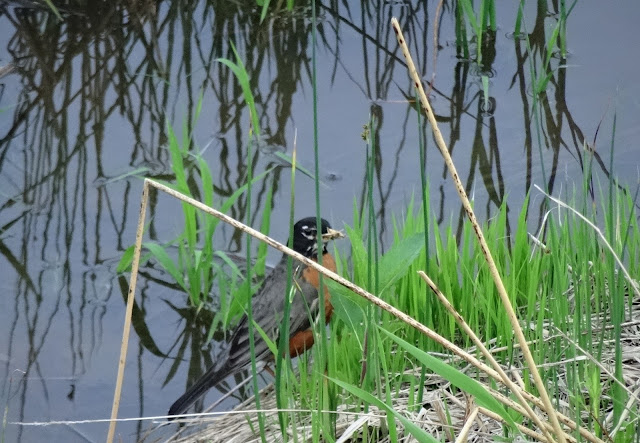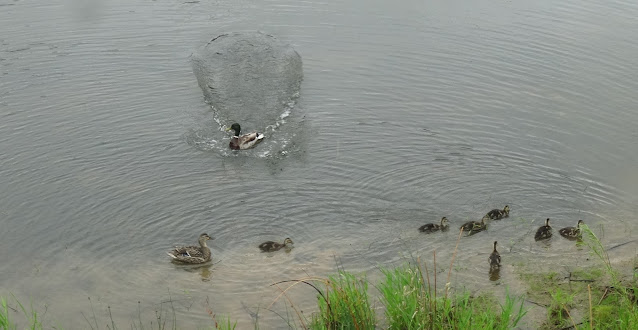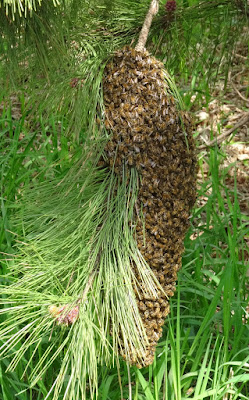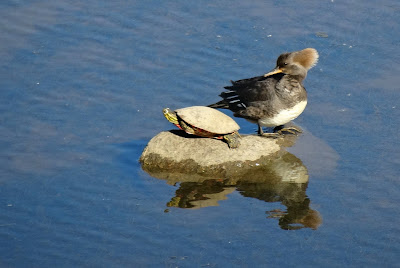On closer look, one of the young geese struggled with a piece of plastic netting caught in the hinge of its bill. The gosling was able to keep up with the others but we wonder about its future health.
6/10/2021
goslings
On closer look, one of the young geese struggled with a piece of plastic netting caught in the hinge of its bill. The gosling was able to keep up with the others but we wonder about its future health.
6/09/2021
mallow
Small wildflowers grow in the riparian area surrounding the pond. Some are invisible to the casual observer because of their small stature, or because they are hidden by the many taller grasses and reeds.
One of these tiny weedy wildflowers is Common Mallow Malva neglecta, with 5 petals of palest pink with stronger pink stripes.
The leaves resemble geraniums but the two families have different reproductive structures.
Mallow is also called 'Cheeseweed' since each seed looks like a miniature wheel of cheese.
6/01/2021
northern blue flag
Iris versicolor, the Northern Blue Flag, is blooming near the pond. It does not mind having its 'feet' wet and often grows in a few inches of water.
The blue to purple flowers stand out from the grasses and reeds around it, but the sword-like leaves blend into all that green!
This plant attracts both butterflies and hummingbirds, and may be known as Blue Flag Iris, Harlequin Blue Flag, Northern Iris, and Wild Iris.
5/30/2021
5/29/2021
robin
Robins nesting by the pond have 4 eggs in their nest. The female gathered food items on the shore while taking a break from incubating her clutch. It looks like she caught an insect larva, but Robins also eat grubs, snails, spiders, beetles, grasshoppers, termites, crickets, and other insects.
5/27/2021
golden alexanders
Wildflowers are blooming in the pond area. Zizia aurea Golden Alexanders feed bees, wasps, flies, and beetles with pollen and nectar. The larvae of some butterflies also feed on this native plant.
5/22/2021
green heron
5/21/2021
hooded merganser ducklings
Today the Hooded Merganser female showed up on the pond with 15 ducklings. This species nests in a cavity, probably in a tree or stump nearby. Once the eggs hatch, the ducklings follow the mother to water. They fed for a while, then she signaled them to rest. They followed her to shore and gathered under her wings. Well, sort of . . . there were many of them!
They dive under water to find small fish, amphibians, clams, mud crabs, crayfish, tadpoles, frogs, and aquatic insects and other crustaceans. They also consume some aquatic plants.
5/20/2021
5/16/2021
bee swarm
By Sunday morning they had all gone from the tree branch, no trace left behind of their weekend stay.
5/11/2021
convivial Merganser
The Mallard has been hanging around for weeks while his mate sits on her nest of eggs. Sometimes we see the pair of Mallards together when the female comes out for meals; they dabble together on the shores. That day, the Merganser was happy to float with one or both. This afternoon, she was again present and just as friendly to the turtle who had been sitting on the rock since morning. What a friendly neighbor to all.
5/05/2021
blue-winged teal pair
5/03/2021
fox sparrow
5/02/2021
phoebes
5/01/2021
spotted sandpipers
A flock of shorebirds stopped today at the pond on their migration trip. Spotted Sandpipers Actitis macularius, catch food in several different ways. Like most other sandpipers, they probe into sand or mud with their bills looking for food -- aquatic larvae of insects, beetles, worms, snails or crustaceans. And like herons, they also lunge at moving small fish in the water, pick insects off plants, or snap at flying prey.
4/30/2021
basking turtles
Many Painted Turtles Chrysemys picta live in the pond. On sunny days they climb out of the water and bask in the sun to warm their blood. In this temperate Spring weather, they spread all their appendages including head and neck out of the shell to get maximum exposure.
4/21/2021
blue-wing teal
4/18/2021
tree swallow, first of 2021
Migration brings something new each day! We saw several Tree Swallows, actively aerial hunting over the pond for any flying insects they could eat. One checked out the nestbox where a pair raised a clutch of eggs successfully last year. They moved on, but the box is ready in nesting season for Bluebirds or Tree Swallows making their way here.
4/16/2021
dove on rock
The Mourning Doves Zenaida macroura spent winter near the pond in nearby bushes and tree cover. This one is celebrating Spring by investigating the water and rocks in the pond.
https://www.allaboutbirds.org/news/why-dont-birds-get-cold-feet/
https://www.birdnote.org/listen/shows/why-birds-feet-dont-freeze
4/12/2021
golden alexanders
Many native plants are coming up through their winter blankets of grasses and mulch. The Golden Alexanders Zizia aurea will be displaying their golden yellow flowers in just a few weeks.
4/09/2021
hooded mergansers
4/06/2021
tamarack rosettes
There are several trees in the riparian area around the pond. One is the Tamarack Larix laricina or American Larch. It is just starting to flower, before sprouting its fresh bright green soft needles. Tamarack is a native deciduous conifer; it is in the pine family but sheds needles (leaves) in Autumn.
4/05/2021
lovey doves
Mourning Doves being lovey-dovey. A small flock has been here all winter, coming to the feeders for nourishment. These two hang together now since it is mating season. One was feeding the other a morsel, a sure sign of courtship. The male of this species is slightly larger than the female, and he has a pink chest.
4/03/2021
hooded mergansers
Late on this balmy Spring day, a pair of Hooded Mergansers landed on the pond. They might be migrating, needing a place to stop and rest. We watched them paddle around a bit near the far shoreline. As the sunlight dimmed, the turtles who spent the afternoon warming themselves on the rocks started swimming back into the pond. Neither species seemed to be bothered by the other. This turtle sat comfortably with the ducks for a long time, each enjoying the end of winter.





























